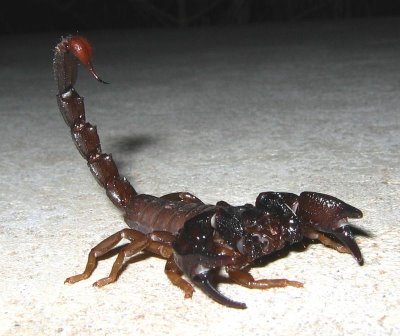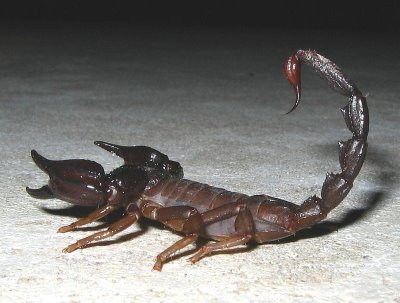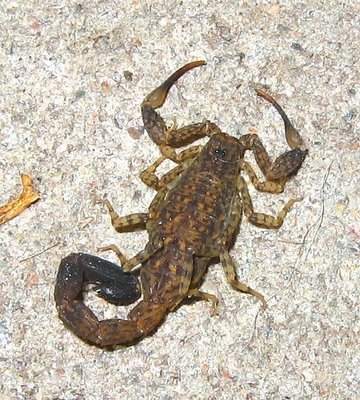Scorpions have between six and twelve eyes, but these are very small and not very effective, however they have parts that are highly sensitive to movement and ground vibrations. With these they can detect mates and prey, the latter (depending on the size of the scorpion) can include beetles, spiders, other scorpions, centipedes, reptiles, frogs and small mammals. They are preyed upon by nocturnal birds, mammals, reptiles, centipedes and other scorpions, so life can also be hazardous.
This scorpion is at the smaller end as far as Australian scorpions are concerned, these are usually around 3 cm in length and very slender.


These Marbled Scorpions are amongst the most mobile and common of the Australian species and do on occasion enter houses, but are more often found under items lying around the garden.
These scorpions are called Sand Scorpions (Urodacus species, currently under revision) because they build deep spiralling burrows in sandy soils. They normally don't move far from their entrance, whilst lying in wait to ambush passing prey.

Sand Scorpion, Urodacus species
The large claws are used to grasp the prey whilst bringing the stinger down to dispatch it. After a while the injected digestive juices turn the inner contents of the dead animal turn to a soup, which is then consumed up by the scorpion. There is very little wastage with this process and few meals a year are required.
Note the stinger and how it points outwards to make striking more efficient and probably more powerful by being able to thrust with its weight, rather than a weaker downward stabbing motion. This downward stabbing motion (of the fangs) is used by the burrowing mygalomorph spiders, but with their anatomy they can get more power/weight using this attack mode.

Scorpions can take up to six years to reach sexual maturity and may even live for 25 years or more. So if you have any, you have plenty of time to get to know them.


...all Australian scorpions are not dangerous to people, unlike some deadly African and American species...
ReplyDelete*hugely surprised*
Is the story that scorpions, when cornered, will commit suicide, truth or fiction?
Hi antares, must admit I was initially very surprised when I saw my first large Australian scorpion as I had no idea they could be so large, But despite their intimidating appearance, they are relatively harmless to people.
ReplyDeleteThe scorpions I have had cornered with the camera made no attempt to commit suicide and I would doubt if many, if any animal, would do so. Their natural reaction is to run away, play dead or as a last resort, defend themselves.
Thanks for your interest.
Jack
Hi Jack
ReplyDeleteI just found a scorpion crawling into my 5yr old sons room. It appears to be the marbled scorpion but I am not sure, it has similar traits but it looks thinner and the main body is darker, it is approximately 2cm long. We live in Bruce Rock in the central wheatbelt. Are they common here? Your blog was the most informative. Thanks,
Naomi, Bruce Rock
Hi Naomi,
ReplyDeleteYour scorpion certainly sounds like one of the Marbled ones. There are more than one species and they are widely distributed.
I have noticed a few about recently, so they have likely been less active in the drier weather. This inactivity probably means they are even thinner than usual, but the size you mention is about right, plus they tend to look like little skinny matchsticks wandering around.
Apart from a sting like bee, they are harmless, so just move them on and you probably won't see them again.
Thanks for your comments.
Jack
Hi,
ReplyDeleteJust found what looks like your Marbled Scorpion on our bathroom floor. Gave me quite a surprise.It was only about 1cm long though. We are in Moora, WA.
Glad to know these ones are not life threatening!
Thanks for the information.
Nicole.
Hi,
ReplyDeleteI wish I had known about the marbled scorpian before I found one .... in the good old Aussie dunny with my pants around my ankles and the scorpian sitting (laughing at me I think) from inside the roll of toilet paper!
Despite not being deadly, they certainly look fierce and I made pretty good time getting out of there. About the only time I have seen one in WA.